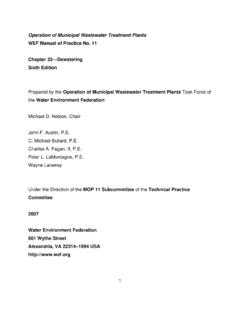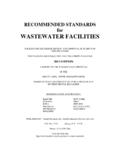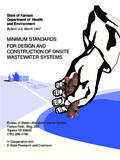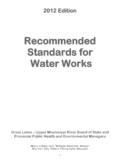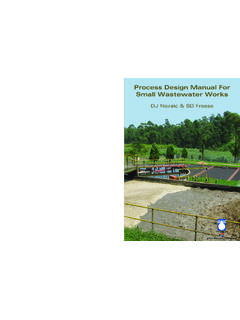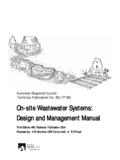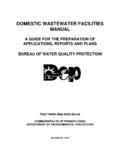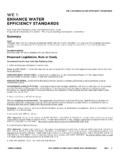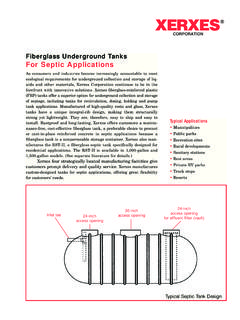Transcription of Operation of Municipal Wastewater Treatment Plants
1 1 Operation of Municipal Wastewater Treatment Plants WEF Manual of Practice No. 11 Chapter 31 Aerobic Digestion Sixth Edition Prepared by the Operation of Municipal Wastewater Treatment Plants Task Force of the Water Environment Federation Michael D. Nelson, Chair Elena Bailey, , C. Michael Bullard Reza Shamskhorzani, Under the Direction of the MOP 11 Subcommittee of the Technical Practice Committee 2007 Water Environment Federation 601 Wythe Street Alexandria, VA 22314 1994 USA 2 About WEF Formed in 1928, the Water Environment Federation (WEF) is a not-for-profit technical and educational organization with 32,000 individual members and 80 affiliated Member Associations representing an additional 50,000 water quality professionals throughout the world.
2 WEF and its member associations proudly work to achieve our mission of preserving and enhancing the global water environment. For information on membership, publications, and conferences, contact Water Environment Federation 601 Wythe Street Alexandria, VA 22314-1994 USA (703) 684-2400 IMPORTANT NOTICE The material presented in this publication has been prepared in accordance with generally recognized engineering principles and practices and is for general information only. This information should not be used without first securing competent advice with respect to its suitability for any general or specific application. The contents of this publication are not intended to be a standard of the Water Environment Federation (WEF) and are not intended for use as a reference in purchase specifications, contracts, regulations, statutes, or any other legal document.
3 No reference made in this publication to any specific method, product, process, or service constitutes or implies an endorsement, recommendation, or warranty thereof by WEF. WEF makes no representation or warranty of any kind, whether expressed or 3 implied, concerning the accuracy, product, or process discussed in this publication and assumes no liability. Anyone using this information assumes all liability arising from such use, including but not limited to infringement of any patent or patents. Copyright 2007 by the Water Environment Federation All Rights Reserved. Water Environment Research, WEF, and WEFTEC are registered trademarks of the Water Environment Manuals of Practice of the Water Environment Federation The WEF Technical Practice Committee (formerly the Committee on Sewage and Industrial Wastes Practice of the Federation of Sewage and Industrial Wastes Associations) was created by the Federation Board of Control on October 11, 1941.
4 The primary function of the Committee is to originate and produce, through appropriate subcommittees, special publications dealing with technical aspects of the broad interests of the Federation. These publications are intended to provide background information through a review of technical practices and detailed procedures that research and experience have shown to be functional and practical. Water Environment Federation Technical Practice Committee Control Group B. G. Jones, Chair A. B. Pincince, Vice-Chair S. Biesterfeld-Innerebner R. Fernandez S. S. Jeyanayagam Z. Li M. D. Nelson S. Rangarajan E. P. Rothstein A. T. Sandy A. K. Umble T. O. Williams J. Witherspoon 5 Contents Chapter 31 Aerobic Digestion Introduction to Aerobic Digestion Description of Aerobic Digestion Processes High-Purity-Oxygen Aerobic Digestion Autothermal Thermophilic Aerobic Digestion Advantages Disadvantages Typical Design Consideration for the Autothermal Aerobic Digestion System Nitrification is Inhibited in the Autothermal Aerobic Digestion Process Effect of Liquid Sidestreams that Contain Ammonia-Nitrogen Foam Equipment Design Prethickening Basin Configuration
5 Post-Autothermal Aerobic Digestion Storage/Dewatering Cryophilic Aerobic Digestion Conventional (Mesophilic) Aerobic Digestion 6 Design Techniques to Optimize Aerobic Digestion Prethickening Advantages of Prethickening Increased Solids Retention Time and Volatile Solids Destruction Accelerated Digestion and Pathogen Destruction Rate Temperature Elevation Categories of Prethickening Category A Thickening Treatment Process: Batch Operation or Decanting of Aerobic Digester Category B Thickening Treatment Process: Continuous-Feed Operation Using Sedimentation After Digestion Category C Thickening Treatment Process: Using a Gravity Thickener in Loop with Aerobic Digestion Category D Thickening Treatment Process: Using Membranes for In-Loop Thickening with Aerobic Digestion Category E Thickening Treatment Process.
6 Using Any Mechanical Thickener Before Aerobic Digestion Basin Configuration Staged Operation or Batch (Multiple Basins) Aerobic Anoxic Operation Nitrification and Denitrification Alkalinity Recovery and pH Balance Energy Savings Dissolved Oxygen and Oxygen Requirements 7 Nitrogen Removal in Biosolids and Filtrate or Supernatant Phosphorus Reduction in Biosolids and Biophosphorus Option I: Liquid Disposal No Restriction of Phosphorus on Land Application Option II: Dewatering, Post-Thickening, and Supernating, with Limit Restriction of Phosphorus on Land Application Temperature Control Flexibility of the System Equipment Design and Selection Types of Reactors Piping Requirements Diffused Aeration Equipment Mechanical Surface Aerators Submerged Mechanical Aerators Blowers Pumps Mixing and Aerating Equipment Control Equipment Thickening Equipment Process Performance Rules and Regulations Standards for the Use or Disposal of Sewage Sludge Regulation of Land Application 8 Definition of Biosolids Parameters Used to Evaluate Performance of Aerobic Digesters Standard Oxygen Uptake Rate Pathogen Reduction Volatile Solids Reduction and Solids Reduction Solids Retention Time Temperature Product Nitrogen Removal in Biosolids
7 Phosphorus Reduction in Biosolids and Biophosphorus Sludge Dewatering Characteristics Supernatant Quality of Recycled Sidestreams Process Control Process Startup General Guidelines for Process Startup Preferred Procedure for Startup Preferred Choice for Process Startup Second Choice for Process Startup Operational Monitoring Equipment Troubleshooting Clogging of Air Diffusers Blowers and Valves Mechanical Aerators Freezing Solids Deposition 9 Process Troubleshooting Increased Organic Loading Nuisance Odor from Digested Sludge Excessive Foaming Low pH (High Ammonia) Low Dissolved Oxygen Data Collection and Laboratory Control Data Collection Maintenance Management Program Maintenance Tasks Aeration and Oxygen Supply System Mixing and Pumping Equipment Instrumentation and Control Equipment Scheduling Records References 10 List of Tables Table Page Table Effects of digester improvement techniques on digester performance Table Recommended design parameters for ATAD digester systems Table Thickening Treatment process alternatives Table Summary of the nitrification and denitrification equations Table Volatile solids (VS)
8 Reduction at minimum operating temperatures and minimum SRT Table Typical levels of polymer addition for belt-filter press and solid-bowl centrifuge sludge dewatering Table Acceptable characteristics of supernatant from aerobic digestion systems Table Data from a category C process at the Stockbridge, Georgia WWTP Table Recommended values for primary and secondary monitoring parameters 11 List of Figures Figure Page Figure Data from the ATAD facility in Gemmingen, Germany Figure A five-stage batch Operation setup using membranes for in-loop thickening as part of an aerobic digestion process Figure A five-stage, in-series Operation setup using membranes for in-loop thickening as part of an aerobic digestion process Figure Evaluating the effect of digestion temperature on the concentration of total nitrogen in the filtrate shows that the highest concentration of total filtrate nitrogen occurred at 30 C and the lowest at 20 C Figure Effect of pH levels in an aerobic digester Figure Effect of low dissolved oxygen in pathogen destruction and volatile solids destruction Figure Effect of anoxic cycle on VSS removal Figure Polyphosphorus release and uptake of phosphorus during sludge digestion Figure Option I: prethickened liquid disposal with no phosphorus limit restriction on land application Figure Option II.
9 Dewatering post-thickening, with phosphorus limit restriction on land application Figure Study conclusions of temperature effect in the performance of aerobic 12 digesters Figure Flow schematic of sludge Treatment process, Plum Creek, Colorado Figure Volatile solids reduction of Plum Creek, Colorado, versus solids concentration and temperature Figure Volatile solids reduction (VSR) of each in-series stage, at Plum Creek, Colorado Figure Effect of temperature on VSS removal with an anoxic cycle of 8 hours Figure Cover requirements for cold-weather installations with 3% solids feed Figure Reduce first stage to 1% solids in the summer to control temperature and post-thickener before liquid haul Figure A schematic of the flow diagram of Paris, Illinois Figure A schematic of a pre- and post-thickening system Figure Two-stage sludge Treatment dewatering option Figure Three-stage sludge Treatment liquid disposal option Figure Typical installation of National Aeronautics and Space Administration draft tube at Paris, Illinois.
10 Picture taken after conversion from anaerobic to a prethickened two-stage, in-series, aerobic digester system, treating a combined primary and secondary waste. Figure The plan and section views of a digester basin at Paris, Illinois Figure Airflow distribution and blower requirements for a three-stage, prethickened aerobic digester system Figure A typical ATAD system schematic and reactor schematic Figure A schematic of an aerator used in an ATAD system 13 Figure Selection of SRT temperature (days C) product for feed with high degradable solids content Figure Selection of SRT temperature (days C) product for feed with low degradable solids content Figure High solids Operation at Los Lunas, New Mexico, in four-stage, prethickened, covered, and insulated digester system 14 Preface This sixth edition of this chapter was produced under the direction of Michael D.
